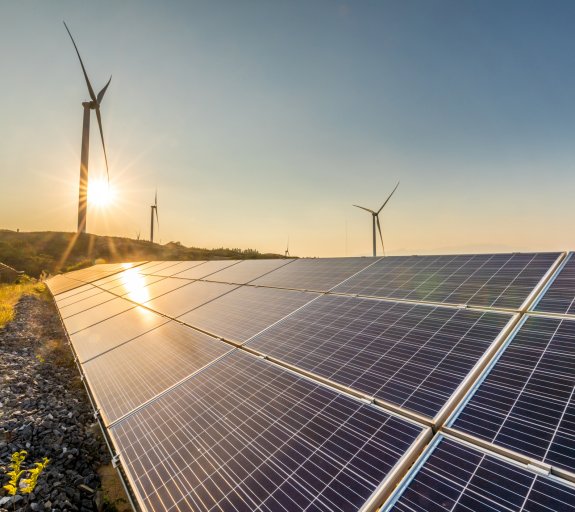
How investments are fueling the low-carbon economy
A year after the Inflation Reduction Act (IRA) and CHIPS Act, renewed efforts in the US surrounding the energy transition are well underway, offering investors potential opportunities to capitalize.
With government policies increasingly supporting low-carbon initiatives, the U.S. is seeing notable growth in clean technologies such as renewables, electric vehicles (EVs), grid upgrades, battery storage, and low-emission fuels. This trend is apparent on a global scale as well, with solar investments poised to surpass investment in oil production for the first time.1
Although the shift to a low-carbon economy may impact some existing investments, it also has the potential to introduce compelling new financial opportunities, with the U.S. and global economy alike experiencing growth and innovation in critical sectors.
Recent government policies fuel a significant U.S. energy boom
The U.S. is undergoing a clean energy boom as recent government policies drive a gold rush among businesses and investors:
- Inflation Reduction Act. Since the IRA was signed into law in August 2022, American Clean Power reports some $263 billion in new clean energy investments as of July 2023 — an amount equivalent to all U.S. clean power investments between 2016-2022.2
- CHIPS and Science Act. Beyond boosting the semiconductor industry, the $280 billion CHIPS Act from August 2022 earmarked a quarter of its funding – roughly $67 billion – for low-carbon industries and climate research.3 Worth considering for investors looking at future growth opportunities, this funding is expected to speed the development and scale-up of new, innovative green solutions for the 2030s and beyond.
- Local ordinances. Pushing businesses and investors to shift resources toward cleaner solutions, many cities and states are passing carbon-limiting policies, such as Denver’s green city codes, Portland’s low-carbon concrete ordinance, and New York City’s clean construction executive order.4 Legislation like this may further reward the companies finding innovative ways to limit carbon emissions, and in turn, their investors.
The impact of these policies is already wide-reaching. Current investments are expected to double the amount of nationwide clean power generation, with clean energy generation projects planned in nearly every state (which will also boost state and local tax revenue).5 Meanwhile, consumers are estimated to save some $4.8 billion on energy costs.6 These policies will likely continue to push job growth, beyond the 114,000 new clean energy jobs the U.S. added in 2022.7
This is just the start. Many of these clean energy projects are still in the design and planning stages, and their full economic and job creation potential will emerge over the next few years. Today’s investors are still in the early stages of an ongoing economic shift, one which projects to endure as more the government passes similar legislation, funds research, and incentivizes companies – and investors – to take advantage.
At the same time, failure to act poses a financial risk to the U.S. economy. In the immediate term, the U.S. needs modernized grids, renewable energy generation, and battery storage to protect against losses from increasingly volatile weather. In the long term, without significant investment in the energy transition, the U.S. could experience economic damage from climate change equivalent to 1-10% of GDP per year by 2100.8
Key sectors make the move to low-carbon solutions
In the U.S. power sector, renewable energy sources are increasingly popular alternatives to traditional fossil fuels. Solar has grown by an annual average of 24% in the last decade and saw $35 billion in private investment in 2022.9 In April 2023, the Biden administration announced $82 million in funding for domestic solar manufacturing and recycling,10 opening up additional investor opportunities. Meanwhile, wind power in the U.S. has grown to provide 10.3% of the country’s electricity, saw $13 billion invested in 2022 alone, and supports nearly 126,000 jobs with 44% job growth expected over the next decade.11
Since the IRA’s passage in August 2022, nearly 80 new or expanded manufacturing facilities for wind, solar, and battery have been announced.12 Other manufacturing and industrial sectors are also transitioning to low-carbon operations, opening the door for investors to support solutions such as:
- Industrial electrification: Just 20% of the energy consumed in the industrial sector was electricity as of 2020, yet using technologies available today, electricity in theory could replace nearly 50% of the fuel used.13
- Carbon capture: The Global Cement and Concrete Association plans to reach net zero by 2050 and have ten carbon capture plants by 2030,14 while the iron and steel industry requires 75% of its CO2 to be captured to meet emissions targets.15
- Hydrogen fuel: Hydrogen could serve as a low-carbon replacement for industrial processes that require fuel. The Department of Energy is dedicating up to $100 million for hydrogen and fuel cell research and development to explore this promising solution.16
At the same time, the automotive sector is currently shifting toward EVs, supported in part by the IRA’s tax credits. President Biden aims to have 50% of all new vehicles sold in the U.S. be electric by 2030,17 and California mandated all new cars must be electric by 2035.18 Meanwhile, consumer enthusiasm is rising, with 36% of Americans actively interested in and 35% open to the possibility of buying or leasing an EV.19 And the numbers support the hype: EV sales rose by 60% in 2022.20
Global growth trends in green infrastructure and investments
At a global level, investment in green technologies has risen from $1 trillion in 2015 to $1.7 trillion in 2023, surpassing fossil fuel investments of about $1 trillion.21 This rise in green infrastructure is expected to have an outsize impact on the economy, raising global GDP by $98 trillion by 2050 and quadrupling jobs over the next thirty years.22
A few key factors have driven this global push to a low-carbon economy:
- Economic opportunity. In Europe, companies are creating strategic initiatives that combine economic and climate objectives,23 while Mexico and Latin America already produce several minerals vital for clean energy transitions.24
- Geopolitical instability. Amid the ongoing conflict in the region, Russian oil exports to the EU dropped from 2.4 mb/d in January 2022 to 0.6 mb/d in January 2023,25 while pipeline deliveries of natural gas fell by roughly 80% in 2022.26 Prices rose amid the shortages, benefiting some investors but raising concerns about continued volatility in this market.
- Affordability. Low-carbon energy infrastructure is less expensive to operate than coal- and gas-based infrastructure, which could equate to potential energy savings of $4.6 trillion from 2015 to 2035.27
The shift to a low-carbon future is well underway
In the U.S. and globally, public and private support is flowing toward the low-carbon economy. New policies and incentives are rapidly pushing industries and investors toward greener opportunities. With everyone from the automotive industry to the power sector shifting to clean energy alternatives wherever possible, the energy transition is already on its way to reshaping the economy.
- International Energy Agency (5/25/2023): Clean energy investment is extending its lead over fossil fuels, boosted by energy security strengths
- American Clean Power (7/20/2023): Clean Energy Investing in America
- The Atlantic (8/10/2022): Congress Just Passed a Big Climate Bill. No, Not That One
- Smart Cities Dive (1/26/2023): How green building policy could evolve in 2023
- U.S. Department of Energy (06/28/2023): U.S. Energy and Employment Jobs Report
- American Clean Power (7/20/2023): Clean Energy Investing in America
- U.S. Department of Energy (06/28/2023): U.S. Energy and Employment Jobs Report
- World Resources Institute (7/28/2020): 10 Charts Show the Economic Benefits of US Climate Action
- Solar Energy Industries Association (Q2 2023): Solar Industry Research Data
- U.S. Department of Energy (04/20/2023): Biden-Harris Administration Announces $82 Million Investment
- American Clean Power (2023): Wind Power
- American Clean Power (7/20/2023): Clean Energy Investing in America
- McKinsey (5/28/2020): Plugging in: What electrification can do for industry
- Reuters (8/29/2022): Explainer: How industry is depending on carbon capture technology for climate goals
- Reuters (8/29/2022): Explainer: How industry is depending on carbon capture technology for climate goals
- U.S. Department of Energy (6/23/2020): DOE Announces New Lab Consortia to Advance Hydrogen and Fuel Cell R&D
- The White House (4/17/2023): FACT SHEET: Biden-Harris Administration Announces New Private and Public Sector Investments for Affordable Electric Vehicles
- NPR (1/30/2023): New cars in California must be zero-emissions by 2035. Can the power grid handle it?
- Kelley Blue Book (07/07/2022): Survey: 36% of Americans May Buy an EV
- Reuters (3/21/2023): One-third of Americans would consider EV purchase - Reuters/Ipsos poll
- International Energy Agency (2023): Overview and key findings
- United Nations Development Programme (UNDP) (5/29/2020): The growing urgency of shifting to a low carbon economy
- Brookings (4/12/2022): The US should treat climate policy as economic policy
- International Energy Agency (4/7/2023): Latin America’s opportunity in critical minerals for the clean energy transition
- International Energy Agency (Feb 2023): Russia's War on Ukraine
- International Energy Agency (2023): Overview and key findings
- Climate Policy Initiative (October 2014): Moving to a Low-Carbon Economy: The Financial Impact of the Low Carbon Transition
Risk Warning:
Investment involves risk including the loss of capital.

Our experts and investment teams outline their key convictions
Visit the Investment InstituteDisclaimer
This document is being provided for informational purposes only. The information contained herein is confidential and is intended solely for the person to which it has been delivered. It may not be reproduced or transmitted, in whole or in part, by any means, to third parties without the prior consent of the AXA Investment Managers, Inc. (the “Adviser”). This communication does not constitute on the part of AXA Investment Managers a solicitation or investment, legal or tax advice.
Due to its simplification, this document is partial and opinions, estimates and forecasts herein are subjective and subject to change without notice. There is no guarantee forecasts made will come to pass. Data, figures, declarations, analysis, predictions and other information in this document is provided based on our state of knowledge at the time of creation of this document. Whilst every care is taken, no representation or warranty (including liability towards third parties), express or implied, is made as to the accuracy, reliability or completeness of the information contained herein. Reliance upon information in this material is at the sole discretion of the recipient. This material does not contain sufficient information to support an investment decision.
© 2023 AXA Investment Managers. All rights reserved